| Article ID | Journal | Published Year | Pages | File Type |
|---|---|---|---|---|
| 1202997 | Journal of Chromatography A | 2014 | 9 Pages |
•Novel application of TurboFlowTM–LC–MS/MS in environmental analysis.•Method provides simultaneous analysis of multi class endocrine disruptors.•Efficient clean up of sediment and sludge extracts obtained.•Low LOQs were obtained (0.0083–1.6 and 0.10–125 ng/g for sediment and sludge).
A novel fully automated method based on dual column switching using turbulent flow chromatography followed by liquid chromatography coupled to tandem mass spectrometry (TFC–LC–MS/MS) was applied for the determination of endocrine disruptors (EDCs) and related compounds in sediment and sewage sludge samples. This method allows the unequivocal identification and quantification of the most relevant environmental EDCs such as natural and synthetic estrogens and their conjugates, antimicrobials, parabens, bisphenol A (BPA), alkylphenolic compounds, benzotriazoles, and organophosphorus flame retardants, minimizing time of analysis and alleviating matrix effects. Applying this technique, after the extraction of the target compounds by pressurized liquid extraction (PLE), sediment and sewage sludge extracts were directly injected to the chromatographic system and the analytes were concentrated into the clean-up loading column. Using six-port switching system, the analytes were transferred to the analytical column for subsequent detection by MS–MS (QqQ). In order to optimize this multiplexing system, a comparative study employing six types of TurboFlow™ columns, with different chemical modifications, was performed to achieve the maximum retention of analytes and best elimination of matrix components. Using the optimized protocol low limits of quantification (LOQs) were obtained ranging from 0.0083 to 1.6 ng/g for sediment samples and from 0.10 to 125 ng/g for sewage sludge samples (except for alkylphenol monoethoxylate). The method was used to evaluate the presence and fate of target EDCs in the Ebro River which is the most important river in Spain with intensive agricultural and industrial activities in the basin that contribute to deteriorating soil and water quality.
